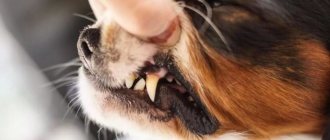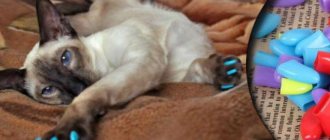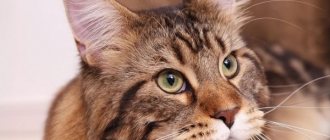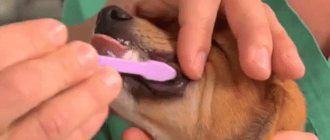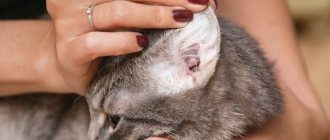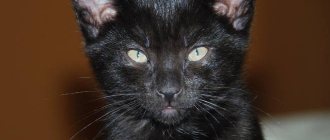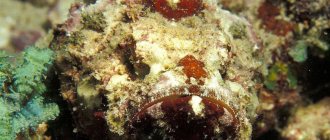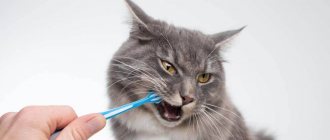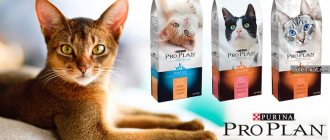In apartment cats, tartar often forms - a calcareous deposit on the base of the tooth, almost at the very gum. First, a soft coating appears, then, if it is not removed, it thickens and becomes stone-like. The animal cannot get rid of it on its own, especially if it receives soft food.
The process of mineralization (stone formation) itself is painless and does not bring any unpleasant sensations to the cat, but if measures are not taken in time, big problems can arise, including sepsis. Pet owners regularly ask specialists questions about how tartar is removed from cats and how to prevent its occurrence.
Reasons for appearance
Tartar is formed from saliva, food debris, and mineral salts. The plaque, at first insignificant, subsequently thickens and hardens, acquiring a yellowish-brown tint. The localization of formations is in the areas of the back teeth and fangs. This is a long process, sometimes lasting six months.
The following factors contribute to the appearance of tartar:
- Dishes from the master's table, soft food. Lack of dry food.
- Metabolic disorders (salt and mineral).
- Malocclusion.
- Anomalies of the dentition.
- Avitaminosis.
- Poor care of teeth and gums.
- Heredity.
The appearance of formations on teeth should not be ignored: calcified plaque creates a favorable environment for pathogenic microorganisms. In addition, the harder it is, the more difficult it is to clean it later.
Preventive measures
It is recommended to visit the veterinarian once every six months so that he can examine the animal’s oral cavity for the formation of tartar. If it is not possible to visit a veterinary clinic, you need to regularly examine your pet yourself.
Timely cleaning of teeth from plaque (about once every 5 days) can significantly reduce the risk of tartar formation. It is recommended to introduce the animal to this procedure from a very early age so that its indignation does not interfere with cleaning.
There are a variety of toothpastes and brushes on the market that are made specifically for cats, but you can simply use your index finger to clean the plaque off your teeth.
Regular dental examination and brushing are the most effective means of preventing dental plaque.
The food your cat eats should contain tough ingredients and grass. There are foods on sale that contain special granules that clean the surface of the teeth mechanically and contain polyphosphates; they settle on the teeth and prevent the formation of plaque. Taking multivitamins helps maintain dental health. And by allowing your cat to chew on cartilage, chicken necks, or letting you play with a toy, you will reduce the likelihood of plaque on your teeth to a minimum.
If an animal has digestive diseases, they should be treated in order to restore the chemical balance in the mouth and thereby reduce the risk of tartar formation.
Video: how to properly brush your cat's teeth
Clinical picture
Tartar can be subgingival or supragingival.
Subgingival tumors form under the gum. They can only be detected during an examination, which is carried out using dental instruments. The stones fit tightly to the neck of the tooth, are hard, dark brown, and sometimes black.
Supragingival stones are accordingly formed above the gum and are visible even with the naked eye. They are easily separated from the enamel, have a porous but solid structure, and a yellowish tint.
Clinical picture: the appearance of bad odor from the mouth, inflammation and bleeding of the gums, loose teeth. The animal experiences severe discomfort, refuses food, especially solid food, and loses weight.
Early and late stage symptoms
You can determine whether your pet suffers from tartar plaque on their teeth by a number of symptoms:
- a strong putrid odor emanates from the animal’s mouth even at the initial stage;
- on the base of the tooth, near the gum itself, a dark plaque is visible to the naked eye, the shade of which can reach brown in advanced cases;
- the gums are red and inflamed and begin to bleed at the slightest contact with food;
- hypersalivation is noted - excessive secretion of saliva, it occurs at any stage of the disease;
- unstable position of teeth, sometimes – their loss;
- swelling of the animal's oral mucosa;
- behavior that is unusual for an animal while eating - restlessness, attempts to move away from the bowl and immediately return to it, dissatisfied growling, strong slurping;
- complete refusal of solid food;
- scratching cheeks on corners of furniture.
It is worth remembering that some symptoms individually may be manifestations of another disease. For example, bad breath often characterizes a malfunction of the gastrointestinal tract or the development of cancer (in this case, the smell has a putrid-sweet character). Rubbing the muzzle against a surface may indicate an allergic reaction or the presence of ear mites.
Diagnostics in a veterinary clinic
For an experienced veterinarian, diagnosing tartar in cats is not difficult. In a veterinary clinic, this is carried out using a routine examination.
The cat owner can determine for himself whether his pet has this problem. To do this, just carry out a simple test: moisten a cotton swab with Lugol’s or iodine solutions (5%) and rub your teeth with it, grabbing the gums adjacent to them.
After performing this manipulation, the stone is clearly visible.
Predisposition and risk groups
It is noted that among purebred cats there is a higher risk of developing tartar.
This is due to the dishonesty of many breeders, who ignore the signs of breeding marriage and congenital diseases that are inherited.
These are the breeds that are in greatest demand: Persian, British, Scottish, Siamese, Thai.
Treatment method and prognosis
Tartar removal is carried out in a veterinary clinic. The procedure is performed under general anesthesia. The duration of the operation is 1 hour.
Two methods are used to remove mineralized deposits on the surface of teeth - ultrasonic and mechanical.
For mechanical cleaning, dental instruments are used and it is carried out manually. The procedure is inexpensive, but has a significant drawback - possible damage to the enamel. That is why veterinarians recommend mechanical removal only in cases of complete contraindication to general anesthesia.
The ultrasound method is a modern and absolutely painless procedure performed using special equipment. Ultrasound is able to cope with the hardest calcareous deposits, peeling them off from the tooth tissue.
During the procedure, not only plaque is removed, but also pathological microorganisms are destroyed, periodontal pockets and interdental spaces are cleaned. The method is absolutely safe, since the enamel is not damaged, and anesthesia is used only to immobilize the pet.
Since after brushing the teeth, the enamel acquires a rough surface, which creates the preconditions for the re-formation of stone, polishing is necessary. Ideal enamel smoothness is achieved using special pastes and brushes.
Fluoridation (applying a special varnish or gel with sodium fluoride to the teeth) is a desirable, but optional step in cleaning tartar. With this procedure, tooth hypersensitivity is reduced and the enamel is strengthened, making it less vulnerable to caries.
Cleaning without anesthesia
As a rule, cleaning a cat's teeth is carried out under general anesthesia, as it is very painful for the animal. Each method takes up to 40 minutes.
Important!
Cleaning without anesthesia is only done on old and weakened animals with chronic diseases for which anesthesia is dangerous: pathologies of the heart, kidneys, and liver. In this case, the doctor observes maximum caution and uses special painkillers and sedatives for cats.
What to do at home
You should not try to remove tartar on your own, as this can cause serious injury to your pet. The procedure is carried out exclusively in a veterinary clinic under general anesthesia.
For prevention purposes, it is advisable to periodically give your cat special food. Dry granules prevent plaque by binding calcium contained in saliva and provide complete mechanical cleaning of teeth.
Veterinarians note that in cats who consume medicated food, the layer of plaque decreases, its growth slows down, and in addition, the natural shade of tooth enamel is restored.
Prevention
The condition of your pet’s oral cavity must be monitored from an early age.
- Give solid food and treats that promote self-cleaning of the enamel, and after 4-5 years, special food. Dried tendons have proven themselves very well. In summer you can give your cat grass.
- Clean your pet's teeth daily.
- Give someone special vitamins in courses.
- Visit the dentist once every six months for preventive sanitation.
- Monitor the condition of the cat’s stomach, liver, kidneys and acid-base balance.
Possible complications
Tartar is a health hazard for your cat. As mineral deposits grow, they form a dental pocket and cause gum irritation.
In addition, it contributes to the appearance of dental diseases, such as gingivitis, caries, periodontitis, periodontitis, osteomyelitis, which, in turn, cause not only loosening and loss of teeth, but also purulent processes, sepsis, which create dangerous preconditions for death.
What is tartar
The growth of stones is provoked by ossified remains of food, saliva, putrefactive bacteria, and minerals contained in water. All this enters into a violent chemical reaction with each other. Depending on the location of the formation, there are:
- supragingival;
- subgingival.
The first can be seen in the area of the canines, incisors and premolars. The plaque has a light yellow tint, which gradually darkens and turns brown. The subgingival is located on the very neck of the tooth, in a pocket under the tissues. It is impossible to recognize subgingival tartar in the photo.
What does tartar look like?
The tartar on cats' teeth is a colony of microorganisms. Essentially, it is a ossified plaque on the outside of the teeth.
It includes traces of food, bacteria, dead cells, as well as calcium, phosphorus, and iron salts. What does he look like? Visually, this is plaque or crusts at the base of the animal’s teeth. The color can vary from yellowish to dark brown. It is important to remember that a cat’s tartar is located not only on the visible part of the tooth, but also under the gum. Therefore, diagnosis is often difficult.
Why is it dangerous?
Veterinarians warn that if tartar is not treated in time, the animal may not only lose a tooth, but also die.
The main danger is that the stone on the cat’s teeth grows, forming a pocket in the animal’s gum. Gingivitis, caries, periodontitis, periodontitis, osteomyelitis, fragility of teeth, pulpitis, stomatitis - an incomplete list of diseases resulting from the spread of tartar.
The consequences of these diseases: inflammation, abscesses and fistulas of the gums, the formation of ulcers, swelling, loosening of teeth and their loss, enlarged lymph nodes. As a result of swelling and ulcers on the mucous membrane of the mouth, the cat cannot eat and swallow food normally, which leads to diseases of the stomach and intestines. In addition, inflammation can spread from the mouth to the ear, causing otitis media.
The greatest danger lies in purulent processes that can affect the brain or spread through the bloodstream. In such cases, the animal dies.
Terms of education
The first signs of tartar can be noticed in young cats that are not even a year old, especially if we are talking about purebred representatives. It is known that among elite cats, tartar is more common. On average, the age when pathology becomes obvious is 4-5 years.
Factors influencing the rate of tartar formation in cats:
- poorly prepared diet, especially food from the common table;
- improper bite aggravates problems, making natural self-cleaning impossible;
- nutrient metabolism disorder;
- lack of access to quality drinking water;
- lack of oral hygiene.
Perhaps the first and last points are the most important in this matter. Without regular brushing of teeth, and even with poor nutrition, the cat runs the risk of acquiring stones at a fairly young age.
At-risk groups
Some breeds of domestic cats have a genetic tendency to develop plaque. These include Siamese, British, Scottish fold and Persian individuals.
Also at risk are animals that eat exclusively soft homemade food and do not receive oral care.
Symptoms
It is quite easy to identify the symptoms.
When examining the oral cavity, inflammatory processes are observed on the gums, characterized by redness, swelling, and pain.
Yellow plaque on a tooth is a clear sign of tartar formation.
- The presence of an unpleasant odor from the animal's mouth.
- Yellow or brown plaque at the base of the fangs, the entire jaw - depends on the degree of damage.
- The cat's anxiety while eating, its nervousness, cautious approach to food.
- Complications in the form of growths, neoplasms, and tumors of the mucous membrane are possible.
- Bleeding gums indicate the presence of periodontal disease.
The advanced form increases the risk of gingivitis, and subsequently stomatitis . If an animal frequently shakes its head, this means that there are complications in the form of developing diseases of the ears and nasolacrimal ducts.
Constant pain may indicate pulpitis - inflammation of the dental nerve.
Preventing the formation of tartar on teeth
It is quite possible to prevent the formation of mineralized deposits in your pet’s mouth if you take timely care of its health.
The following preventive measures will help your animal avoid unpleasant procedures:
cat food is selected taking into account the physiological characteristics of the pet’s body: food must be balanced, enriched with a complex of essential vitamins and minerals;- constant brushing of teeth (2-3 times a week) using a paste based on chlorophyll and enzymes;
- Regular visits to the veterinarian in order to identify problems in a timely manner.
If you notice a slight plaque on your pet’s teeth, you should try to remove it using a suitable method. It is not advisable to feed and water the cat half an hour before the hygiene procedure.
How is it formed in a cat?
Plaque on the teeth does not begin to harden immediately; the process takes several months. What stage of formation the deposits are at can be recognized by their shade:
First, food residues and polysaccharides settle on the teeth, in which microorganisms begin to actively multiply. Plaque is fixed through adhesion. At this stage it is still soft, yellowish in color.- Over time, the formation is covered with a film of glycoproteins, protecting the deposits from salivary enzymes. The coating gives the teeth a brownish color.
- Under the influence of bacteria trapped under the film, chemical and physical liming processes develop. As a result, the plaque hardens, turning into stone, and acquires a brown tint (in the presence of pyogenic pathogens, it may be green).
Accumulations accumulate to a greater extent on the front side of the teeth - on the inner surface, plaque is almost completely scraped off by dense pieces of food that the cat gnaws.
How serious is the problem?
Some pet owners perceive colored crowns as a cosmetic defect and are not too worried about it.
This happens due to ignorance of the dangers of limestone. Plaque does not destroy dental tissue, but it causes a lot of other troubles. An infection develops in the oral cavity, affecting the soft tissue of the alveoli and the gum mucosa.
Growths on the crowns cause mechanical irritation on the inner surfaces of the lips and cheeks, causing discomfort in cats while eating food (and not only).
As the formation grows, it penetrates under the gum, becoming the cause of gingivitis, periodontitis and other dental diseases. This causes not only an unpleasant odor from the pet’s mouth, but also leads to brittle teeth.
If you do not pay attention to the growth of stones, the cat may develop ulcers, fistulas, and abscesses on the gums. The lesions quickly grow and gradually move into the ear canals, as a result of which the animal develops otitis media.
Inflammation in the oral cavity prevents the cat from eating, and this leads to diseases of the gastrointestinal tract.
Gradually, the processes enter the purulent phase, and these accumulations spread throughout the body through the bloodstream. Having reached the brain, pus provokes death.
